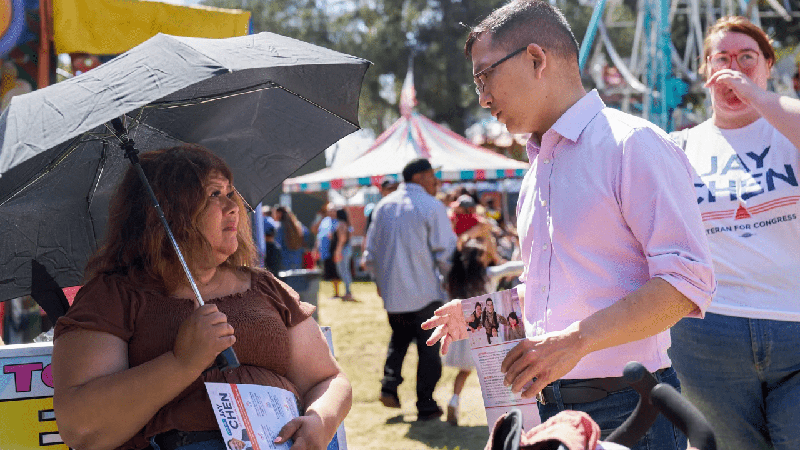Gov. Gavin Newsom spent time and money out-of-state instead of supporting down-ballot candidates.

Democratic candidate ,Jay Chen speaks with voter Ramona Mejia in Spanish while canvassing for voters at the 62nd Garden Grove Strawberry Festival on May 29, 2022. Photo by Bing Guan for CalMatters
By JULIA ROSEN, special to CalMatters
Julia Rosen is a founding partner at Fireside Campaigns and has nearly 20 years of experience organizing for political campaigns and nonprofits.
California Democrats are already looking back at 2022 congressional races with the dreaded woulda/coulda/shoulda even with one race too close to call. There were several House races where Democrats fell short – some close enough where a stronger ground game could have made a difference.
Running field campaigns are expensive. After all, Rick Caruso spent $16 million dollars on field operations alone in his failed mayoral race, and that was just Los Angeles. Statewide campaigns are so prohibitively expensive that it is rarely even attempted in California.
However, one of the ways it could have made a difference was in several close House races. If results hold, the state’s congressional delegation will be largely unchanged. It’s not far-fetched to say that under-investment in get-out-the-vote operations in California cost Democrats their shot at retaining control of Congress.
Modern GOTV operations include digital turnout advertising in addition to the typical field and mail efforts. The majority of midterm campaigns spend nearly all their efforts trying to persuade dropoff voters – folks who didn’t vote in the last midterm elections – or moderate voters without an official party affiliation.
What they don’t typically do – unless they have the cash – is talk to voters who turned out four years prior. In a money-strapped campaign, there is less financial incentive to communicate with folks who presumably will vote. They aren’t in the phone universes. They don’t get digital ads. You just cross your fingers and hope they go back to the polls.
The 2018 midterms saw historically high turnout in California when nearly 65% of registered voters cast a ballot. California is still tallying this year’s results, but it’s clear the state is going to fall well shy of that mark. That means there were a lot of people that campaigns expected to turn out but didn’t.
In many states, there is a coordinated campaign system where the top-of-the-ticket campaigns coordinate all their field efforts with the congressional, legislative and local campaigns. They create field scripts that mention down-ballot candidates and share volunteers. Importantly, they also handle a large amount of digital and mail advertisements that target every voter who isn’t expected to vote for the other side. It creates a ton of efficiencies. Oregon, for example, has long deployed coordinated campaigns, and this year it was particularly important with a competitive governor’s race and key House races for open seats.
Democrats didn’t have a coordinated campaign in California.
The candidates at the top of the ticket won with huge margins because the California Republican Party simply isn’t competitive. There is little to no incentive for folks running for state office or U.S. Senate to share their wealth and support down-ballot candidates with a coordinated campaign.
And that’s what happened. The most recent finance reports show that Gov. Gavin Newsom had at least $20 million in the bank after spending money on out-of-state ads and statewide ad buys opposing Proposition 30, but little investment in down-ballot contests.
That money cannot be transferred to a federal campaign account, either.
It’s no secret that the governor harbors ambitions outside the state. And one of the best ways to build support nationwide is by being a good Democrat, assisting other campaigns and building his reputation with activists, insiders and operators. Newsom could have run a coordinated campaign that was tightly focused on competitive congressional and state legislative districts.
Most importantly, it would have meant shifting the cost of field staff, dialers, peer-to-peer texting platforms, digital GOTV ads from congressional campaigns and to a coordinated campaign. That, in turn, would have freed up more funds for persuasive advertising. It’s just simply a much more efficient way to support candidates in tighter races.
And it just might have made all the difference in securing a few more key House races versus falling short.